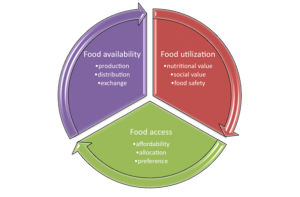Anybody who has considered food accessibility can tell you that it is a complex issue. Our group looked at food access from a global standpoint, addressing questions such as how to end world hunger and the complexities of “free trade”. We have learned that globally, developed countries send their surplus, very cheap food to developing countries with the tagline that they are being evangelists and trying to stop hunger. In reality the massive amount of cheap food flooding the global market, is making it impossible for local farmers to compete in local markets. These countries are also without access to healthy, substantial food because capitalism in developed countries has convinced them that becoming a banana republic that only produces one or two major cash crops is better than producing a variety of food crops that could actually go to feed people in their own country. While many people are aware of the hunger crisis that prevails in the developing world, food insecurity in our own country is less recognized.

https://medanth.wikispaces.com/Food+Security
We grounded our learning about global food access with the idea that a wealthy country like the US, still has food accessibility issues that are driven by the complex political structures and physical infrastructure that exist in todays society. Our learning was aided by the words of two talented UW professors, Dr. Anne Goodchild, a supply chain engineer, and Dr. Elizabeth Wheat, an organic farmers and lecturer in the College of the Environment. We asked them about their opinions on current food access issues, ways to potentially solve these issues, and how we as a part of the UW community can play a role in this change. The two hold extremely different outlooks on the problem of food accessibility and how to solve it, but they are not at odds with each other. Both professors yearn for a global food system that is equitable, efficient, and realistic. Through hearing both of their stories, the necessity for a systems thinking approach is more prevalent than ever. Solving problems of food access first asks that you treat it as the systematic problem it is. Changing one part of the system will undoubtedly impact other areas because equity, environment, and economics are all interconnected. Knowing what you know about systems theory, what are some strategies that could be used when finding solutions for food accessibility?

Hello Kaelyn,
Thank you for the great post that make me reconsider about the food accessibility locally and globally. Under the drive of capitalism, we keep growing more and more to see the GDP to go up, however, the more we care about the growth, one externality is the overproduction. Any food has expire date, and overproduction means it will be sitting there until rusted because nobody will buy it. Then those product been sent to developing countries which just like you said, break the local markets because our cheap product can easily beat their local product on price.
In the system theory you analyze, we need to find a balance point between all the factors in order to recover the system that each element work in their own job instead of overloading. Personally, I will start with capitalism. Under capitalism, there are more equal access but who has better resources, many, and only focus on GDP growth. Then we fix other element individually that can make the whole system work functionally and equally.